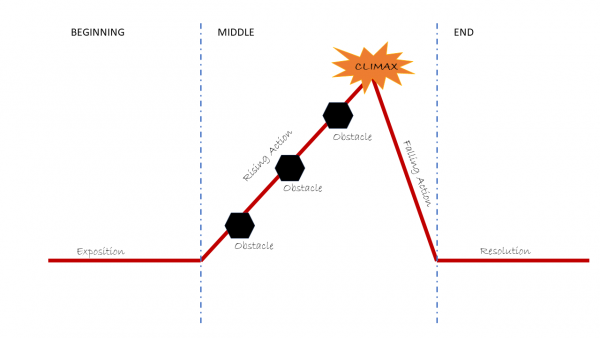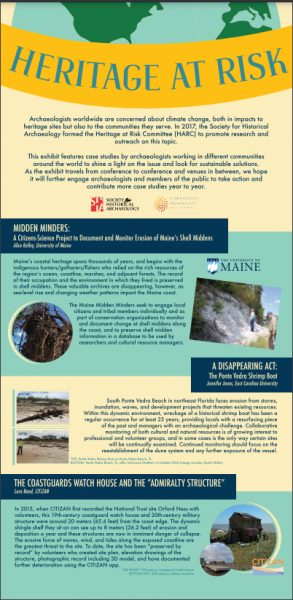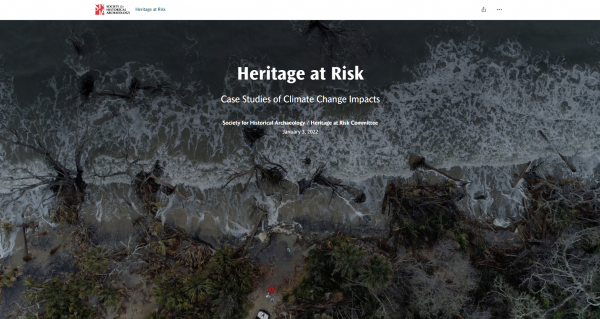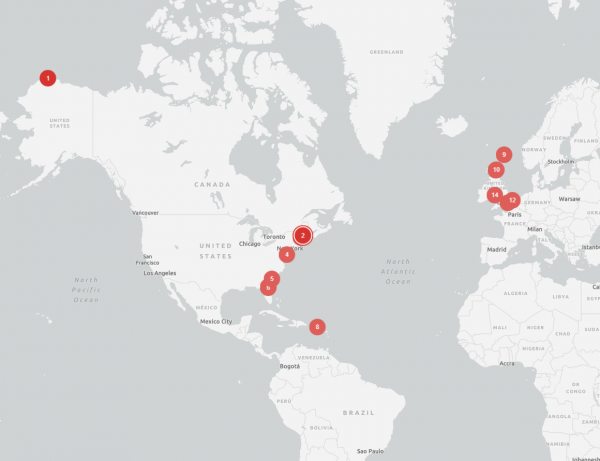Virginia’s Inland Waters Heritage Risk Assessment and Survey
by Elizabeth A. Moore (Virginia Department of Historic Resources) Location: Multiple Rivers in Virginia Problem:…
By Allyson Ropp, Ph.D. Candidate, East Carolina University
Think back to your favorite story. What made it so exciting? Was it the characters? Was it the conflict or problem that the main characters needed to solve? Or was it how the characters ended up solving the problem? Maybe it was all three!
What all good stories have in common is a beginning, a middle, and an end – each setting up an important part of the story that brings you into the action. The beginning is the setup. It provides the exposition of the story, introducing us to the main characters and their world. The middle presents a problem, conflict, or situation the characters must address. This could be a wrecked ship on a voyage home or the loss of a parent, but regardless of what it is, it provides a problem for the characters. The end wraps up the story and allows the characters to solve or achieve a resolution of the problem. While the main character may have experienced a shipwreck on the way home, she was able to alert a passing ship and therefore made it home in time for her sister’s wedding. These three components reflect the “ABT” framework of storytelling.

Figure 1. Story Arc (Ropp, 2023)
The “ABT” framework, or the “And, But, Therefore” framework, has been used in storytelling for years, even if it was known by another name, such as the Hero’s Journey (Olson 2018:6; The Publication Plan 2020). Before this framework, scientists, including archaeologists, fell into the style of storytelling that was “And, And, And,” where all information was presented but did not provide a narrative for the work. Olson saw the need for more effective science communication; therefore, he brought storytelling to science through the ABT Framework (For more information on the ABT Framework, check out his books and TedTalk).
This framework has been utilized by the SHA Heritage at Risk Committee (HARC), drawing on inspiration from Marcy Rockman and Jakob Maase’s article “Every place has a climate story: finding and sharing climate change stories with cultural heritage” (2017). This article champions the use of the ABT Framework as a way to tell stories integrating climate change and cultural heritage, including tangible archaeological remains.
Since its inception in 2017, HARC has used different platforms to tell the climate stories of cultural heritage. One method is the Heritage at Risk – Climate Stories Pop-Up Exhibit. The pop-up exhibit allows archaeologists to share transformational stories of heritage at risk from our changing climate. As archaeologists worldwide are concerned about the multitudes of impacts that climate change can have on tangible and intangible heritage, the exhibit offers a space for archaeologists to learn from one another and share it with the public. This exhibit features a global collection of case studies highlighting the issue and looking for sustainable solutions. All the case studies within the exhibit utilize the ABT Framework to lay out the narrative of the impacted site, the impacts to the site, and solutions undertaken by professional and avocational archaeologists to combat the impacts.

Figure 2. Pop-Up Exhibit Title Panel and Case Studies (Grinnan 2020)
In 2022, the physical pop-up exhibition expanded to include a digital component. To reach a broader audience, the pop-up exhibit became an ESRI StoryMap. This StoryMap took the contents of the physical display, expanded on the stories of each site, and spatially showed the breadth of climate change impacts, allowing HARC to tell a global story about climate change impacts to cultural heritage.

Figure 3. Title card for the HARC Digital StoryMap (Wholey 2019; photo credit South Carolina DNR).
The current exhibits include case studies from North America and Europe. These case studies cover sites dating from the Archaic period to the mid-twentieth century, with site types ranging from shell middens and shipwrecks to plantations and industrial structures. These case studies provide unique context-dependent climate stories and cross-continent comparative examples of similar climate impacts and management strategies. For example, coastal erosion is a common thread in many current climate stories. This erosion impacts shell middens in Maine and Florida, heritage resources and modern-day communities in Alaska, and fishing and industrial sites across the British Isles. While these different sites face a similar threat, the contributions of the contributing partners to this exhibition provide a variety of techniques that can be applied to other sites worldwide. For example, organizations such as the Florida Public Archaeology Network and CHERISH in Ireland and Wales utilize emerging technologies like terrestrial laser-scanning and unmanned aerial vehicle/drone-based photogrammetry to survey sites. Other initiatives, like the Maine Midden Minders, SCAPE in Scotland, and the Society of Black Archaeologists at the Estate Little Princess in St. Croix, leverage community groups to record sites and conduct assessments before, during, and after large-scale erosion events and hurricanes.

Figure 4. Map of current case study locations (Wholey 2019)
Finally, HARC has sponsored several 3-Minute Climate Story panels at the annual SHA conferences. These panels bring together climate stories from around the world. These stories are told using the ABT Framework and Rockman and Maase’s “Every place has a climate story” themes through a video format. To help make cultural heritage research and climate change impacts more accessible for archaeologists and the public, the video allows archaeologists and heritage professionals to tell the story of a site and share the video across different platforms. This year’s 3-Minute Climate Story panel will focus on Rockman and Maase’s first theme – “Change in the Material World.” This theme makes climate change tangible, focusing on how material culture changes and how archaeologists can identify and monitor this change (Rockman and Maase 2017:110).
These storytelling efforts promoted by HARC represent only a small fraction of the sites at risk and the stories that can be told. As heritage sites are facing these impacts across the globe, we want to help you tell the story of a heritage site at risk from climate change. If you are working on a site at risk from our climate crisis, we would love to help share its story and your work in mitigating the effects! Please complete this Google Form to tell us about your site’s story and share it with the larger archaeological community. Are you unsure if your site fits into our exhibition? Want to participate in a future 3-Minute Climate Story session? Email Allyson Ropp at roppal14@students.ecu.edu for more information.
Citations:
Olson, Randy
2018 Don’t Be Such a Scientist: Talking Substance in an Age of Style, 2nd Edition. Island Press, Washington DC.
The Publication Plan
2020 The ABTs of science communication: expert advice from a scientist-turned-filmmaker. The Publication Plan: News for Medical Publication Professionals. https://thepublicationplan.com/2020/11/17/the-abts-of-science-communication-expert-advice-from-a-scientist-turned-filmmaker/. Accessed 7 June 202
Rockman, Marcy and Jakob Maase
2017 Every place has a climate story: finding and sharing climate change stories with cultural heritage. In Public Archaeology and Climate Change, Tom Dawson, Courtney Nimura, Elias Lopez-Romero, and Marie-Yvane Daire, editors, pp. 107-114. Oxbow Books, United Kingdom.